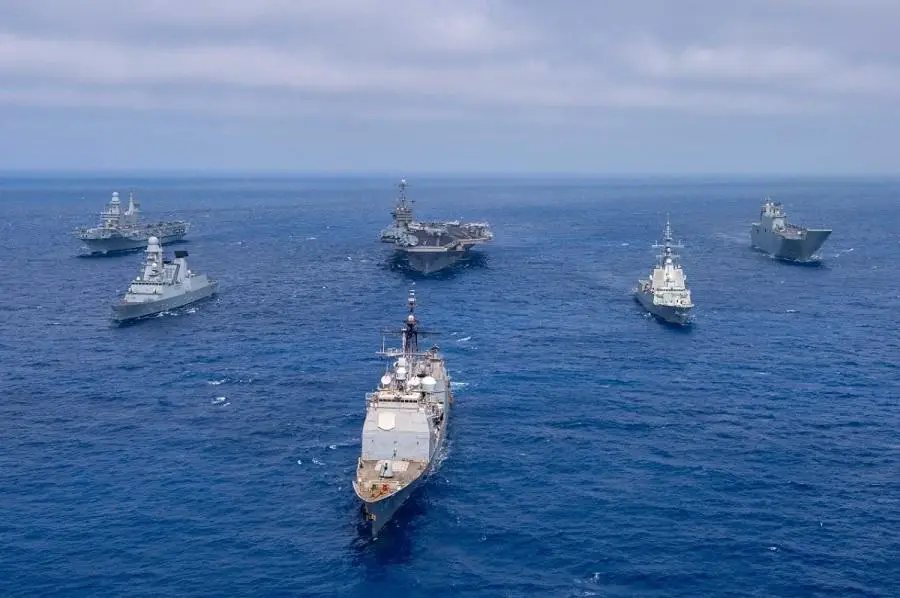Naval Striking and Support Forces NATO (STRIKFORNATO) and U.S. Sixth Fleet (SIXTHFLT) concluded the NATO-led Vigilance Activity NEPTUNE SHIELD 2022 (NESH22) from STRIKFORNATO’s Joint Operations Centre in Oeiras, Portugal, May 31. The two-week vigilance activity demonstrated NATO’s ability to integrate the command and control of multiple carrier strike groups (CSG), an amphibious ready group (ARG) and a Marine expeditionary unit (MEU), involving the participation of 25 NATO Allied and partner nations. NESH22 kicked off May 17th from the Baltic, Adriatic, Ionian and Mediterranean Seas, and involved missions at sea, in the air and on the ground across Europe, supporting both Allied Joint Force Command (JFC) Naples and JFC Brunssum. While STRIKFORNATO executed command and control of the USS Harry S. Truman CSG, the ITS CAVOUR CSG and the Combined Task Force 61/2, which included the USS Kearsarge ARG and the 22nd MEU, Supreme Headquarters Allied Powers Europe (SHAPE) coordinated the activity, integrating NATO Allied Maritime Command and NATO Allied Air Command.
“Demonstrating and enhancing NATO’s high-end maritime warfare capabilities shows the world the true strength and teamwork of our Alliance,” said Vice Adm. Gene Black, commander, STRIKFORNATO and SIXTHFLT. “NATO’s capacity to conduct integrated operations in the maritime domain ensures stability and peace throughout Europe, and validates more than seven decades of Alliance interoperability.”
“Credible force projection to defend the Alliance has to be integrated across multiple domains; sea, air, land as well as space and cyberspace. NESH22 further integrated those domains, and was an essential step in the progression of the NEPTUNE series to demonstrate NATO’s ability to defend against any threat from any direction,” said Admiral Robert P. Burke, Commander, JFC Naples.

STRIKFORNATO led and coordinated maritime and expeditionary forces composed of four carrier strike groups from three different nations, more than 30 ships and 160 aircraft, including forces from the Harry S. Truman CSG, the Kearsarge ARG-MEU, the Italian Navy CAVOUR CSG, the Spanish Navy JUAN CARLOS I CSG and the Standing NATO Maritime Group 1 and 2. More than 200 aircraft sorties and 80 vigilance activities were executed by more than 11,000 personnel from 25 NATO and partner countries. NESH22 is built on previous phases of Project NEPTUNE, a long series of activities originally conceptualized in 2020. In October and November 2021, SIXTHFLT and STRIKFORNATO conducted NEPTUNE CHALLENGE in the Mediterranean and Black Seas onboard SIXTHFLT and STRIKFORNATO’s Blue Ridge-class amphibious command ship USS Mount Whitney (LCC 20). In February 2022, NEPTUNE STRIKE demonstrated the power and cohesiveness of our maritime forces and the NATO Alliance. Previous activities in the NEPTUNE series also included various table-top exercises held between NATO Allied and partner nations. The Project NEPTUNE series is instrumental in creating a stronger, integrated NATO force.
Breaking new ground, NESH22 also delivered on a series of “first-ever events” on behalf of the Alliance. The Transfer of Authority (ToA) of the Italian CAVOUR CSG is not only the first time Italy has transferred command and control of a CSG and F-35B aircraft to NATO, it is also the first time any non-U.S. CSG has flown the NATO flag. Creating opportunities to further enhance Alliance interoperability, NESH22 achieved the first air-to-air refuelling of a Spanish AV-8B from a U.S. F-18 tanker. Also, the first air-to-air refuelling of an Italian F-35B demonstrated the first ever non-U.S. F-35B to re-fuel mid-air by a U.S. F-18 jet. The ability to do so did not exist prior to the start of NESH22 and pave the way for further integration between the U.S. and other F-35 NATO nations, such as Canada, Australia, Denmark, Norway, the Netherlands, and the U.K.
Collectively, these represent the first ever deployment of a NATO Expanded Task Force (NETF) in support of real world vigilance activities. Defined as two or more strike groups, NETF enables the Alliance to generate and deliver effects across the entirety of SACEUR’s area of responsibility. NESH made significant benchmark gains in how Allies efficiently solve dynamic problems across the Allied Command Operations (ACOs) that will enhance capabilities for real world deterrence scenarios. In addition, the Spanish JUAN CARLOS I CSG operated in close coordination with the NETF for the first time, further demonstrating Alliance cohesion, unity, and capability. Nations participating in NESH22 included Albania, Belgium, Bulgaria, Canada, Czech Republic, Croatia, Denmark, Estonia, Finland, France, Germany, Greece, Hungary, Italy, Latvia, Lithuania, the Netherlands, Poland, Portugal, Romania, Slovenia, Spain, Turkey, the U.K., and U.S.














